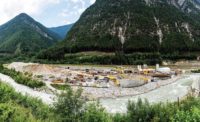Twin earth-pressure-balance tunnel-boring machines Mom Chung and Big Alma emerged into a water-filled retrieval pit in the heart of San Francisco in June, having raised the bar for cutting through variable soils without affecting existing infrastructure. The 350-ft-long, 750-ton TBMs, part of the $1.5-billion Central Subway extension of the Third Street Light Rail transit project, charted a course through the dense subgrade and emerged within an inch of the target, 1.7 miles away from the launch pit.
"We demonstrated new assumptions about how much ground loss can be expected," says Matthew Fowler, project manager for the Parsons Brinckerhoff/Telamon Joint Venture design team. Careful measurement and monitoring boosted accuracy, requiring less fill to overcome soil displacement. The strategy will make future projects less costly, Fowler says.
The twin tunnels represent the second phase of the San Francisco Municipal Transportation Agency transit line. The extension—scheduled for initial ridership in 2018—connects Chinatown and other downtown areas to the initial 5.1-mile surface-rail phase, which runs from Sunnydale to Mission Bay. Future phases are planned to extend the line north.
The TBMs were custom-designed by Robbins Co., Solon, Ohio, for the tunnel contracting joint venture Barnard Impregilo Healy (BIH), Bozeman, Mont., to cut through the ground conditions like a cheese grater. The route under Chinatown—40 ft to 120 ft below grade—contains three types of geology. The first third of the tunnel cuts through Colma formation sands, comprising dense sand and stiff clay. The next section cuts through Franciscan complex bedrock, a mix of sandstone, shale and other rock. At its deepest point, the tunnel passes through San Francisco Bay clay.
Each 21-ft, 7-in.-dia cutterhead consists of 40 disc cutters, including a monocarbide insert cutter. Depending on the soil, the cutterhead softens the path with polyfoamer conditioner for the sand and a liquid polymer, called ACP127, for the clay. Both are designed to be environmentally compatible.
"The soil performed very well," says John Funghi, SFMTA program director.
An augur screw transports the spoils from the high pressure head through the shell to conveyor belts for recycling. The sand is used as fill and the rock goes to a U.S. Environmental Protection Agency Superfund site for use as a cap for hazardous waste disposal.
In its wake, each TBM leaves behind prefabricated concrete liners in six segments per ring, which a seven-person crew welds together. Grout injected from the tail end of the machine fills any void as it is created. "It is all very automated," Funghi says.
Inside the TBMs, redundant measurements ensured consistent pressure in front of the cutterhead. "We measured the weight and the volume on two scales and cross-referenced the readings to control the flow of the fill so we could stay within the optimum design range," says Alessandro Tricamo, BIH's chief engineer.
BIH originally estimated the TBMs would tunnel 40 ft per day, but in some areas actual speed reached 130 ft per day. "Part of that was due to stable ground conditions, but also the team became more efficient at installing the rings," Tricamo says.
To stagger the tunnel work, BIH launched Mom Chung first last July. The TBM arrived at the retrieval pit 8,500 ft away on June 2. BIH launched Big Alma last November. The TBM arrived just 4 ft away from Mom Chung on June 11.
"Big Alma finished twice as quickly as expected," says Fowler.










Post a comment to this article
Report Abusive Comment